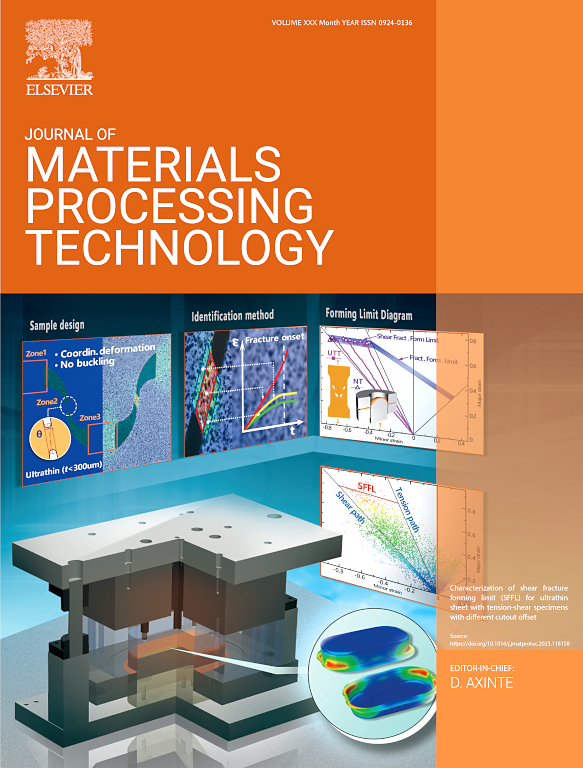铝合金电阻点焊电极点-粘耦合机理及非对称电极结构优化
IF 6.7
2区 材料科学
Q1 ENGINEERING, INDUSTRIAL
Journal of Materials Processing Technology
Pub Date : 2025-06-14
DOI:10.1016/j.jmatprotec.2025.118942
引用次数: 0
摘要
在铝合金电阻点焊(RSW)中,焊条的点蚀和附着导致的熔核尺寸减小一直是制约焊接质量的关键问题。本研究通过控制电极表面条件(附着/点蚀程度)揭示了界面接触特性对熔核演化和力学性能的影响,并提出了基于曲率半径匹配的电极优化策略。结果表明:当83 %的电极端面未出现点蚀时,接触电阻的增加减少了热传导,扩大了熔核直径,拉伸剪切性能提高了6.3 %;然而,这种条件降低了焊接稳定性,诱导了核等轴晶的再结晶,减少了晶体缺陷。当点蚀面积小于26% %时,对合金的力学性能影响不显著;当麻点面积超过55% %时,熔核尺寸减小6.7 %,拉伸剪切性能下降21 %。为了解决点蚀问题,提出了大曲率半径上电极和小曲率半径下电极的组合方案。实验和仿真验证表明,上电极通过增加接触面积使电流分布均匀来延缓点蚀,电极寿命提高2.5倍;下电极(R80)采用小曲率半径集中发热,使熔核尺寸增大6.1 %,拉伸剪切性能提高6.4 %。此外,本研究首次发现焊接过程中熔核边缘的电流聚集导致了环形点蚀现象,随着熔核的膨胀,点蚀向外移动。该研究为RSW电极设计提供了一种通用的“功能分区优化”策略,并为电极降解机理的分析和优化提供了理论基础。本文章由计算机程序翻译,如有差异,请以英文原文为准。
Mechanism of pitting-adhesion coupling in aluminum alloy resistance spot welding electrodes and optimization of asymmetric electrode configuration
In resistance spot welding (RSW) of aluminum alloys, the reduction in nugget size caused by electrode pitting and adhesion remains a critical challenge restricting welding quality. This study reveals the influence of interface contact characteristics on nugget evolution and mechanical properties by controlling electrode surface conditions (adhesion/pitting degree), and proposes an electrode optimization strategy based on curvature radius matching. The results show that when 83 % of the electrode end face is adhered without pitting, the increased contact resistance reduces heat dissipation, expands the nugget diameter, and improves the tensile shear properties by 6.3 %. However, this condition decreases welding stability and induces recrystallization of the nugget equiaxed crystals, reducing crystalline defects. When the pitting area is less than 26 %, no significant effect on mechanical properties is observed; when the pitting area exceeds 55 %, the nugget size decreases by 6.7 %, and the tensile shear properties decline by 21 %. To address pitting issues, a combined scheme of an upper electrode with a large curvature radius and a lower electrode with a small curvature radius is proposed. Experimental and simulation validations show that the upper electrode delays pitting by increasing the contact area to uniform current distribution, enhancing electrode life by 2.5 times; the lower electrode (R80) utilizes a small curvature radius to concentrate heat generation, increasing the nugget size by 6.1 % and improving tensile shear properties by 6.4 %. Additionally, this study first discovers that current aggregation at the nugget edge during welding leads to a ring-shaped pitting phenomenon, which shifts outward as the nugget expands. This research provides a universal "functional partition optimization" strategy for RSW electrode design and a theoretical basis for analyzing and optimizing electrode degradation mechanisms.
求助全文
通过发布文献求助,成功后即可免费获取论文全文。
去求助
来源期刊

Journal of Materials Processing Technology
工程技术-材料科学:综合
CiteScore
12.60
自引率
4.80%
发文量
403
审稿时长
29 days
期刊介绍:
The Journal of Materials Processing Technology covers the processing techniques used in manufacturing components from metals and other materials. The journal aims to publish full research papers of original, significant and rigorous work and so to contribute to increased production efficiency and improved component performance.
Areas of interest to the journal include:
• Casting, forming and machining
• Additive processing and joining technologies
• The evolution of material properties under the specific conditions met in manufacturing processes
• Surface engineering when it relates specifically to a manufacturing process
• Design and behavior of equipment and tools.
 求助内容:
求助内容: 应助结果提醒方式:
应助结果提醒方式:


